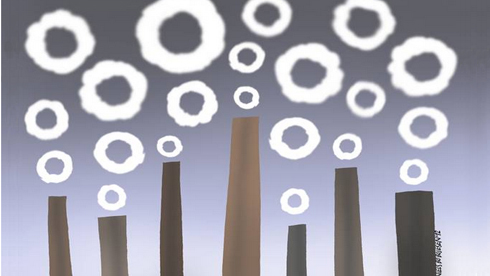Pumping out CO2 ought to cost industry a tidy sum. That’s the whole idea of the EU’s emissions trading scheme. Today, however, the EU’s flagship instrument makes climate-wrecking cheap like never before. Time for Europe to grab the emergency brake.
Europe's best and most important tool for climate protection is, to put it drastically, threatened with collapse. For months now the certificates for carbon dioxide emissions have been plunging in value, which means it’s becoming cheaper and cheaper to pump greenhouse gases into the atmosphere. The principle of the emissions trading has been turned upside down: originally, an artificial scarcity of permits was meant to raise the price of emitting those harmful gases. Now, however, there are too many permits and not enough buyers. If nothing changes, the emissions trading scheme could lose its raison d’etre for years to come, making it totally irrelevant.
Ostensibly, the fall in prices is part of the logic of the system. The crux of that system is a European cap on carbon dioxide emissions that applies to all power plants and factories. If the emission permits are in short supply, their price on the market rises. That upwards pressure also makes it worthwhile to invest in more efficient equipment. Factories that fail to modernise pay the costs of more permits.
The principle itself is actually ingenious. If the economy slows, the price for the permits falls, because factories are pumping out fewer emissions. The current downturn in the price, though, reflects both the recession across a large part of Europe and the conversion of the energy supply to cleaner sources. The more clean green electricity is fed into the grid, the lower the demand for the certificates. This, though, only partially explains the recent fall in the price.
Power of the lobbyists
The real problems of the European emissions trading scheme go deeper, and are rooted not least in the enormously successful lobbying of European industry. Right from the beginning, companies were given ample emission rights. When they needed more, they could be bought abroad cheaply. And what they did not need to use up that year could be stored away for the future.
Result: the third trading period, which began last month and will run until 2020, is now estimated to have a surplus of nearly two billion certificates floating about begging for buyers. That’s more than four years’ supply for German industry. Naturally, the price has stagnated, at around €5 per tonne. What the Environment Committee of the European Parliament initiated on Tuesday therefore is no more than an emergency bailout. In the next few years, 900 million certificates are to be taken off the market to stabilise the price. Follow-up interventions of that nature may be rather clumsy tunings in a market-based system, but as things stand, they are the only way to keep the emissions trading scheme from deteriorating into a farce.
The main reason is that the Europeans are unable to make up their minds about the only logical next step: raise their climate goals. Four years ago, the EU countries set out to cut their emissions of greenhouse gases by a fifth by 2020, using 1990 as the benchmark. This goal is already as good as met. An overabundance is the logical consequence – and possibly as soon as 2013, not 2019. Raising the climate target to 30 per cent is long overdue, not least as a signal to the other industrialised nations.
Short-sighted Germany
It’s just that Germany isn’t being a very good role model. The federal government, once so fond of pioneering climate protection, could urge the reforms in Brussels along. But it is keeping mum.
This is short-sighted in several ways. On the one hand, due to the low price of CO2 emissions, coal-fired plants, which are among the worst offenders when it comes to air pollution, are increasingly pushing gas-fired plants into the background – just those flexible systems so desperately needed as a back-up for fluctuations in wind and solar power. On the other hand, the climate fund that the German government wants to use to support the energy revolution has been shrinking – €1.4bn in proceeds from the auctioning of allowances could go missing in 2013 alone. All this could easily be solved.
Instead, Berlin is observing how the European emissions trading – the world's first market-based instrument for climate protection – is losing its bite. Yet it is the only scheme capable of being globalised and could in the end easily bring in other states. Norway has joined the scheme, and Australia and Switzerland are negotiating the terms with the EU. Elsewhere, China, South Korea, and California are tinkering with trading systems. If Europe were to give up on this tool now, it would be a disaster.
Was this article useful? If so we are delighted!
It is freely available because we believe that the right to free and independent information is essential for democracy. But this right is not guaranteed forever, and independence comes at a cost. We need your support in order to continue publishing independent, multilingual news for all Europeans.
Discover our subscription offers and their exclusive benefits and become a member of our community now!












